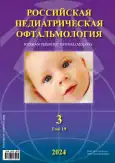Синдром первичного персистирующего гиперпластического стекловидного тела. Особенности хирургии врождённой катаракты и коррекции афакии
- Авторы: Круглова Т.Б.1, Егиян Н.С.1
-
Учреждения:
- НМИЦ глазных болезней им. Гельмгольца
- Выпуск: Том 19, № 3 (2024)
- Страницы: 139-145
- Раздел: Оригинальные исследования
- URL: https://journal-vniispk.ru/1993-1859/article/view/273452
- DOI: https://doi.org/10.17816/rpoj634839
- ID: 273452
Цитировать
Аннотация
Первичное персистирующее гиперпластическое стекловидное тело (ППГСТ) — редко встречающаяся, преимущественно односторонняя врождённая патология глаз, связанная с задержкой обратного развития гиалоидной артерии и эмбриональной сосудистой оболочки хрусталика и часто сочетающаяся с врождённой катарактой (ВК) и микрофтальмом.
Цель. Разработка оптимальной дифференцированной тактики хирургического лечения и коррекции афакии при удалении врождённой катаракты у детей с синдромом первичного персистирующего гиперпластического стекловидного тела.
Материал и методы. В исследовании участвовало 52 ребёнка (54 глаза) с односторонней (50 глаз, 92,6%) и двусторонней (4 глаза, 7,4%) врождённой катарактой с синдромом ППГСТ в возрасте от 3–10 месяцев до 1 года 8 месяцев. На 15 глазах имелся микрофтальм I степени, на 9 глазах — микрофтальм II степени, на 49 глазах — фиброзный тяж, идущий от диска зрительного нерва, на 12 глазах — персистирующая сосудистая сумка хрусталика, на 9 глазах — задние синехии, на 16 глазах — ретрохрусталиковая мембрана с сосудами и фиксированными к ней удлинёнными цилиарными отростками, занимающими от 1/8 до 1/2 площади задней камеры глаза, на 2 глазах — дислокация хрусталика. Проведено комплексное обследование детей, в том числе биомикроскопия, офтальмоскопия, биометрия, тонометрия, кераторефрактометрия, В-сканирование, ультразвуковая биомикроскопия, цветовое доплеровское картирование.
Результаты. Проанализирована клиническая картина глаз с врождённой катарактой в 3 группах детей, объединённых по степени выраженности клинических проявлений синдрома ППГСТ. Представлено описание дифференцированной микрохирургической тактики при удалении врождённой катаракты и показания к имплантации интраокулярных линз.
Заключение. Клиническая картина синдрома первичного персистирующего гиперпластического стекловидного тела у детей с врождённой катарактой характеризуется выраженным полиморфизмом, что определяет необходимость дифференцированного подхода при определении оптимальных сроков операции, хирургической тактики и метода коррекции афакии.
Полный текст
Открыть статью на сайте журналаОб авторах
Татьяна Борисовна Круглова
НМИЦ глазных болезней им. Гельмгольца
Email: krugtb@yandex.ru
ORCID iD: 0000-0001-8801-8368
SPIN-код: 5466-6754
д.м.н.
Россия, МоскваНаира Семеновна Егиян
НМИЦ глазных болезней им. Гельмгольца
Автор, ответственный за переписку.
Email: nairadom@mail.ru
ORCID iD: 0000-0001-9906-4706
SPIN-код: 4765-4725
к.м.н.
Россия, МоскваСписок литературы
- Нероев В.В. Организация офтальмологической помощи населению Российской Федерации // Вестник офтальмологии. 2014. Т. 130, № 6. С. 8–12. EDN: THPQQB
- Круглова Т.Б., Катаргина Л.А., Егиян Н.С., Арестова Н.Н. Хирургическая тактика и особенности интраокулярной коррекции у детей с врожденными катарактами первого года жизни // Офтальмохирургия. 2018. № 1. С. 13–18. EDN: YVQVZN
- Круглова Т.Б., Катаргина Л.А., Егиян Н.С., и др. Отдалённые функциональные результаты после экстракции врожденной катаракты с имплантацией интраокулярных линз детям первого года жизни // Вестник офтальмологии. 2020. Т. 136, № 6. С. 142–146. doi: 10.17116/oftalma202013606142
- Self J.E., Taylor R., Solebo A.L., et al. Cataract management in children: a review of the literature and current practice across five large UK centres // Eye (Lond). 2020. Vol. 34, N. 12. Р. 2197–2218. doi: 10.1038/s41433-020-1115-6
- Sand M.K, Cholidis S., Rimstad K., et al. Long-term outcome of primary intraocular lens implantation in bilateral congenital cataract in infants with a median age of 35 days at surgery: a case series // BMJ Open Ophthalmol. 2021. Vol. 6, N. 1. P. e000836. doi: 10.1136/bmjophth-2021-000836
- Trivedi R.H., Barnwell E., Wolf B., Wilson M.E. A Model to predict postoperative axial length in children undergoing bilateral cataract surgery with primary intraocular lens implantation. Am J Ophthalmol. 2019. Vol. 206. P. 228–234. doi: 10.1016/j.ajo.2019.04.018
- Судовская Т.В. Синдром первичного персистирующего гиперпластического стекловидного тела у детей: особенности диагностики, клиники и хирургического лечения // Российский офтальмологический журнал. 2010. № 1. С. 29–36. EDN: QCLJDX
- Катаргина Л.А., Круглова Т.Б., Кононов Л.Б., Егиян Н.С. Экстракция врожденных катаракт с имплантацией ИОЛ при осложненных формах хрусталика // Практическая медицина. Офтальмология. 2020. Т. 4, № 2. С. 28–30. EDN: PCHGAJ
- Кузнецова Ю.Д., Асташева И.Б., Хаценко И.Е., Зверева А.Н. Тактика ведения и хирургического лечения задней формы III и IV степени синдрома первичного персистирующего гиперпластического стекловидного тела у детей // Современные технологии в офтальмологии. 2022. № 1(41). С. 344–349. doi: 10.25276/2312-4911-2022-1-344-349
- Терещенко А.В., Белый Ю.А., Трифаненкова И.Г., Демьянченко С.К. Особенности клинической картины и хирургии врожденной катаракты в сочетании с синдромом первичного персистирующего гиперпластического стекловидного тела // Катарактальная и рефракционная хирургия. 2013. Т. 13, № 2. С. 10–14. EDN: RCTXCB
- Grenga R., Komaiha C., Bianchi G., et al. Persistenza del Vitreo Primitivo Iperplastico: presentazione di un caso clinico e breve revisione della letteratura [Persistent hyperplastic primary vitreous: case report and literature review] // Clin Ter. 2013. Vol. 164, N. 6. P. e497–503. Italian. doi: 10.7417/CT.2013.1644
Дополнительные файлы












